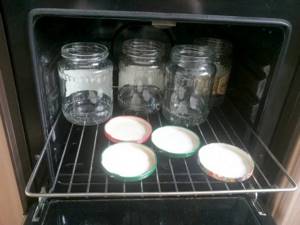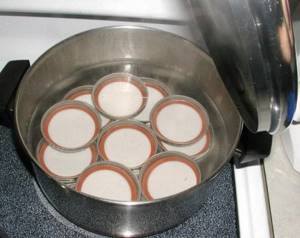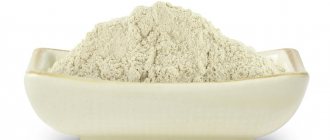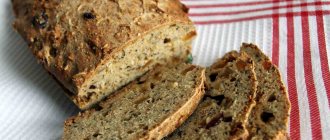Photo: PhotoMIX-Company/pixabay.com Here is a jar of delicious jam. It is beautiful, tasty and so inviting. I really want to try at least one spoonful, but for some reason the jar won’t open. We put it on the table, on the floor, twist the lid with our hands, wearing gloves, through a towel - it doesn’t budge.
How to open a glass jar with a screw cap
The most commonly used is a bottle opener. If it is not at hand, you can break the vacuum under the lid using improvised means.
Oven mitts and gloves
Oven mitts and gloves will help you cope with the problem of slipping. It is better to use a potholder or rubber glove. Cotton tea towels will also do the job. Take an oven mitt, then wrap it around the lid. Press down on it with one hand and hold the container firmly with the other. Turn the cap counterclockwise. To prevent the contents from spilling out, continue to hold it while opening.
Deformation
This method is only suitable if you do not intend to reuse the lid. Take a hard metal object (cutlery is best) and hit the side of the lid until a dent is formed. Deliver the next blow a few centimeters from the previous one. Continue deforming until you hear a click. This will indicate that the vacuum has been broken and you can easily remove the lid.
Heating
Plastic lids may melt, so it is recommended to heat only metal ones. Do not use the heating method if the container has just come out of the refrigerator, as temperature changes may cause the glass to crack. In addition, open the container only with a glove or oven mitt, otherwise you risk burning your hand on the heated metal.
By water
Place the lid down in a bowl of hot (80–90 degrees) water. You will need enough liquid to completely close the lid. Leave the container in the water for 3-4 minutes until you hear a click. The seal is broken due to the fact that the lid expands due to heat. You don't have to immerse it in a bowl, you can just pour hot water over it.
Hairdryer
The source of heat can be not only water, but also a hair dryer (or other heating device). Heat the container. Do this carefully so as not to overheat its contents. Open the heated lid by turning it counterclockwise.
Prying
It is better to use this method for jars made of thick glass, since thin glass can crack due to pressure, and a hole can easily be left in plastic ones. You can pick up the lid with any metal object with a thin end: cutlery, bottle opener, canned food. Find the place where the adhesion of the lid to the jar is least (the edge of the lid should stick out outside the glass). Slide the thin part of the object into the neck so that it is sandwiched between the lid and the jar. Try to pry the metal and break its connection with the glass. Doing this in one place is not enough; you will have to pry the lid until it clicks. It will mean that it will now be easy to open.
Lubrication
You need a little sunflower or olive oil. Place it upside down and drop a little oil on the threads. Leave for 10-15 minutes until all threads are coated with oil. After that you can open it. Be careful, because oil can penetrate inside and spoil the taste of the contents.
Hit the bottom
A blow to the bottom will break the vacuum seal.
Take the container and hold it upside down at a 45 degree angle. Hit the bottom. Calculate the force correctly, the bottom should not crack. If you don't have enough strength to hit the lid, leave it upside down for a couple of minutes. Strike again when all the contents are close to the opposite edge. The impact will create pressure that will release the vacuum. You will hear a click, after which you can easily open the jar. Do you buy jam or make it yourself?
Openers
There are many openers for sale for lids of different diameters. They can be made of different materials: plastic, metal, rubber and different shapes. These are knives, keys, attachments and much more. You can make your own bottle opener in just a few minutes. To do this, you will need a 20–25 cm wooden block, a self-tapping screw and a drill (screwdriver or screwdriver). Screw the self-tapping screw into the side of the block at an angle of 45 degrees at a distance of 2-3 cm from the beginning of the block. The board can be sanded and varnished.
Pre-sterilization

The fact is that pathogenic bacteria die only at high temperatures. Boiling is guaranteed to kill them in a couple of minutes, processing in a slow cooker will require 10, and frying in the oven will take 15 minutes.
In addition to the destruction of pathogenic microorganisms, sterilization performs another function. During heating, the metal of the lid expands slightly, making the rolling process easier.
When cooled, the fixation becomes denser, providing high sealing.
Methods for sterilizing metal caps:
- Boiling. Place the lid in a small container of boiling water for 2–5 minutes. It is important to ensure that the water boils all the time.
- Processing in a slow cooker. Set the cooking mode, pour in about a liter of preheated water, place inside the lid for 10–15 minutes. You can also steam jars at the same time.
- Warming up in the oven. Turn on and heat the device well. Place the washed lids on a baking sheet or rack with the inside facing up. Leave for 15–20 minutes.
- Steam treatment. You can simply hold the products over steam, which, of course, is not very convenient. To simplify the process, you will need a flat wire rack placed over a pan of boiling water. It is important to position the lids so that steam is guaranteed to reach their entire internal surface.

To remove products from boiling water or the oven, use a slotted spoon, tongs or a magnet. When canning, you should use a napkin, dish towel or oven mitts to avoid burning your hands.

The jar should be covered immediately so that the metal does not have time to cool.
There are also options for processing lids without heating. They are soaked in a manganese solution or treated with alcohol.
Metal screw caps cannot be sterilized in a microwave oven.
Magnet for lids
When canning at home, a problem arises - how to remove the lids from boiling water?
A fork or slotted spoon, tongs - all these devices are quite inconvenient.
It is much simpler, faster and, importantly, safer to use a lid magnet for such purposes. This is a stick with a magnet attached to the end.
The magnet is dipped into boiling water, the twist off sticks to the stick, after which it can be placed on the neck of the jar without difficulty or injury.
Methods for opening cans
Canning jars, like glass ones, can be opened using special devices or improvised means.
Can opener
There are several types of can openers: electric, with a metal tip, with a wheel. We will tell you about each of them in more detail.
Electric
Remove the cover using a magnet. You need to place the can under the cutting head, lower it and press the button. Be careful not to open canned food while hanging, as it may fall.
With metal tip
These knives have a wooden handle and a sharp tip. Point the knife towards the lid at a 90 degree angle. Make a hole on the top edge with the sharp part of a knife. Be careful not to let the knife slip, otherwise you may get hurt. Insert the knife into the hole you made and widen it. Then, holding it with one hand, cut the tin, moving in a circle. Do not put your hand near the edges to avoid injury.
With wheel
Spread the handles of the knife and place the wheel on the tin edge of the canned food. Bring your hands together. Be careful, the wheel may come off and hit your hand. Rotate the handle and move in a circle to cut the can. Then remove the cut part of the tin.
An ordinary kitchen knife
Do not open canned food on your knees; the knife may slip off and cut you. Place the tip of the knife on the top of the can and hit the handle to create a hole. Point the knife horizontally and push it under the lid. Cut it along the diameter, pry it with a knife and remove it. Do not touch the edges as they are very sharp.
Stone
This method requires a flat stone. Rub the raised rim of the bottom of the jar, pressing lightly onto the stone. It is necessary to rub the tin until liquid begins to flow out of it. If you notice water coming through, turn it over. Squeeze the edges of the container, increasing the force evenly. The lid will spring back and the cans will open. If you rub too long and still no moisture has formed, hit the jar with a stone so that it becomes deformed. Then squeeze the sides of the cans and they will open.
tablespoon
A hard metal spoon is best for this. The hardest part will be making the hole. You can rub the jar with a spoon until a hole appears or press down on it. It is better to press on the tin near the edges, there it is softer, and it will be more convenient for you to make a hole. Make a hole large enough to fit a spoon, and then run it around the entire diameter.
With my own hands
If you don’t have any tools on hand to open a can, you can do it yourself. This method is only suitable for canned goods that have grooves on the sides, since the container can be bent in this place. Press the grooves on one side to make dents in the tin.
If you lack arm strength, place the container on the ground and press down with your heel.
The dent should be very deep and reach the opposite side. Repeat the same on the other side. You need to crumple the jar so that it is shaped like an hourglass. Now hold the tin container horizontally, pressing on both sides. Enlarge the dents until the middle becomes very thin and breaks. You will open the can by simply tearing it in half. Be careful, tin particles may get inside.
How to easily deal with a screw cap
Most often, such jars open without much difficulty, but sometimes, no matter how hard you try, nothing works. One of my friends constantly performs a funny trick: with the words “Open up, police!” taps the lid with his finger, and then unscrews it with a slight movement of his hand. I don’t understand how she does this, it doesn’t work for me. But fortunately, there are many other proven methods.
- Use a special key
. It's good if you have a special can opener for such lids in your kitchen drawer. It works both for twisting and unscrewing, without damaging either the glass of the jar or the lid. Maybe it’s worth purchasing it, especially since it’s so inexpensive? - Hit
. The easiest way to open a jar without a key is to turn it over and, holding it suspended, slap the bottom, or, conversely, place it on your palm and hit the lid. It almost always works, except in very difficult cases when the problem is not the vacuum, but the fact that the lid is stuck.It’s worth knowing this secret: it’s better to twist the jar, not the lid.
- Increase the hitch
. If the cause of difficulty is your hands slipping, proceed as follows. The jar, lid and hands should be dry and grease-free. Put a rubber or silicone glove on your hand (regular gloves you use when washing dishes work well). In mild cases, you can get by with a kitchen towel. Polyethylene film increases the grip of the lid and the hand very well. Sandpaper can also help. Place some kind of “gasket” on the lid and start unscrewing the jar from the lid, and not vice versa. True, you still have to apply a considerable amount of torque. And if your hands also hurt, then this method is definitely not for you. - Use the laws of physics
. Take a leather belt and thread it through the buckle. Throw the resulting loop over the lid and tighten it tightly, directing it counterclockwise. Then rotate so that the can goes clockwise and the lid goes counterclockwise. - Knock
. Gently tap the top and sides of the tight lid with something wooden or plastic - a spatula, the handle of a knife. Do this carefully so as not to damage the jar. If the reason is not that the lid is too worn in, after such manipulations the jar will open without difficulty. - Take a ride
. A simple method often helps: place the jar on its side, and roll the edge of the lid along the edge of the countertop several times back and forth, slightly pressing on top with your hand. The tightly pressed surface of the edge of the lid will relax a little, making a quiet pop, after which the jar will open quite easily. - Heat
. Fill a bowl with hot water and place the jar in it with the lid down. Leave it like this for 10 minutes, then remove it and open it. Running hot water will also work well if you place the illumination jar under an open tap. When exposed to heat, the lid expands and is easier to unscrew. You can also place a very hot towel on the lid. And the fastest way to heat the lid is boiling water: just pour it over the sink directly from the kettle for a few seconds.Please use caution. If too hot water hits a very cold jar, the glass may crack.
- Depressurize
. Is the problem that the cap has retracted too much under the vacuum? This means you need to ensure air access inside the can. Insert a table knife between the neck and the lid and carefully turn it a little, moving the edge of the lid to the side, away from the glass. A gap of 0.5 mm is enough for depressurization to occur.You can do this with a can opener, or in general with any one that you don’t mind, but if you plan to use this jar with a lid further, it is better to take a table knife with a blunt rounded end - it will not damage the glass or scratch the lid.
- Lubricate the thread
. For jars with honey and jam, this method is suitable: place the jar upside down, and drop a little vegetable oil in several places between the neck and the lid. Leave for 15–20 minutes. This time should be enough for the oil to penetrate into the cracks, lubricate the surfaces and make it easier to unscrew the lid.By the way, this “oiling” also has a pleasant bonus: the oiled thread will not stick for a long time in the future. You just need to make sure that the oil does not get inside the product itself.
Photo gallery: Helpers for opening screw-on glass jars
Try opening a jar with a screw cap while wearing household gloves. The belt method is very old, but effective. Keys for screw caps work on the principle of minimizing your efforts to unscrew. Hot water perfectly heats the lid and the air inside the jar, after which opening it will not be difficult Vegetable oil perfectly lubricates the threads of a screw-on jar and makes it easier to unscrew. Take a knife with a thick round end to avoid chips and scratches, and pry the lid, letting air under it











